Auroville Case Study
Introduction
Raw earth for building has been used worldwide for millennia but during the 20th century most of the skills of earth builders were lost and building with earth became marginal. Through the endeavour of the Auroville Earth Institute, Auroville is today reviving these traditional skills and demonstrating that earth is a noble building material which can be used for manifesting modern, harmonious and progressive architecture for the third millennium.
From the early days of Auroville, in the 1970’s, different experiments have been made with earth building, with mixed results. The creation of the Auroville Earth Institute in 1989, the construction of the Visitors’ Centre from 1989 to 1992 and the development of Vikas Community from 1992 to 1998, started a new era in earthen architecture in Auroville.
This Visitors’ Centre of 1200 m² was granted the “Hassan Fathy Award for Architecture for the Poor” in 1992. Built of compressed stabilised earth blocks, it demonstrated the potential of stabilised earth as a quality building material. Vikas Community was a finalist for the “World Habitat Award 2000: and its 3rd building was built on 4 floors. Since then, the value of earth as a building material has been acknowledged for its economic advantage, as well as its comfort and quality, which promotes indigenous and sustainable development. Today, Auroville can show a wide variety of earthen projects: public buildings, schools, apartments and individual houses.
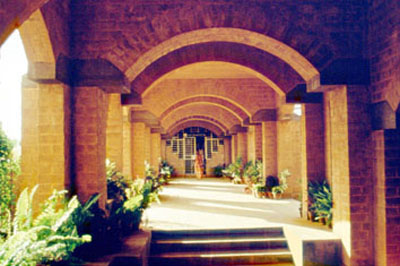

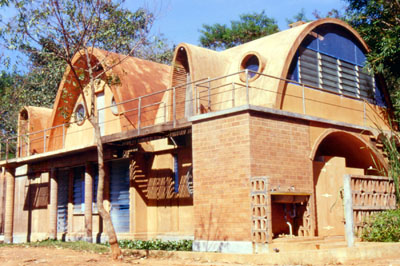
Most of the projects are built with compressed stabilised earth blocks (CSEB), as this technology benefits of more than half a century of research and development worldwide. Stabilised rammed earth is also used extensively for foundations and to a lesser extent for walls. In Auroville, CSEB present several advantages compared to the local country fired bricks:
• Walls made of CSEB and stabilised rammed earth are always cheaper than fired bricks.
• The initial embodied energy of CSEB produced on site with 5 % cement is ~ 4 times less than the local country fired bricks.
• The strength of these blocks is most of the time higher than the local country fired bricks.
There are also three other earth techniques used in Auroville. These techniques are very marginally used as only about 10 buildings have been built with them:
• Raw rammed earth
• Adobe blocks, the traditional sun dried mud brick
• Wattle and daub which is mud plastered on a wattle made of split bamboo or palmyra tree
A GOOD EARTH TO BUILD WITH
The Auroville red soil got its colour from iron oxides, which give excellent properties and make remarkable building materials. In Auroville, the earth is stabilised with about 5% by weight of cement. The lime quality around Auroville is not high enough to be used. Further the soils from Auroville are mostly silty sands and they are not suitable for lime stabilisation. Hence cement is more suited to stabilise the earth.
MANAGEMENT OF RESOURCES
When building with earth, one should pay a lot of attention of the management of resources. Topsoil should be scraped away, so as to be re-used for agriculture or gardens. One should always plan how the excavation would be used afterward. A proper management of the earth resources can create a new and harmonious balance between nature and the buildings, where each enriches and completes the other. Auroville shows various possibilities for the use of quarries: as water harvesting ponds, waste water treatment ponds, pools, basement floors or shallow depressions which are used for landscape design, work or play areas, gardens, etc.

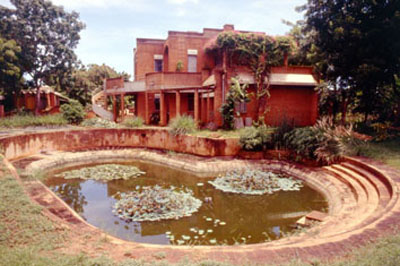
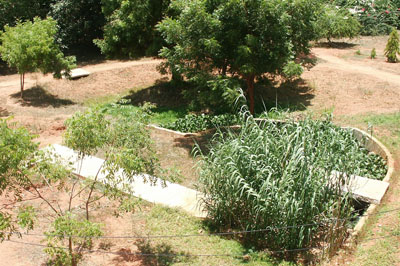
COMPRESSED STABILISED EARTH BLOCKS
CSEB is nowadays the earth technology, which is the most used worldwide, as well as in Auroville, because it represents a synthesis between traditional practices and a modern technology.
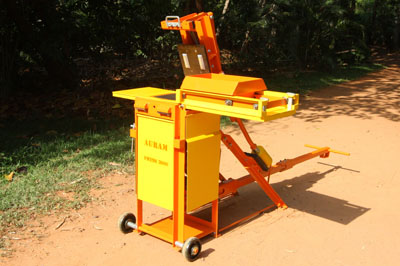
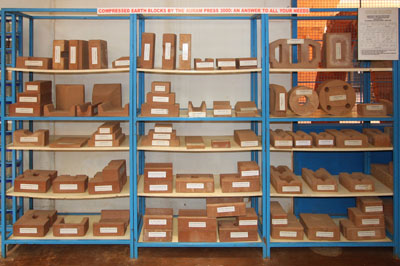
In Auroville, CSEB are stabilised with 5% cement and have an average dry compressive crushing strength of 50 kg/cm2 (5 Mpa) and a wet compressive crushing strength of 25 kg/cm2. The water absorption is around 10%. Country fired bricks have resist at around 35 kg/cm² for the dry compressive strength and have a 12% water absorption rate.
The Auroville Earth Institute has designed manual presses for CSEB, the Auram, which are manufactured in Auroville by Aureka, one of its steel workshops. Today, the press 3000 for compressed stabilised earth blocks is being sold worldwide on all continents. Many machines have been sold in Asia, South Asia and Africa. Nowadays, more and more presses are being sold to USA, Middle East and Europe.
APPROPRIATE BUILDING TECHNOLOGIES BASED ON EARTH
The main research and development is focussed on minimising the use of steel, cement and reinforced cement concrete (RCC). Most of the technologies developed have now been mastered and the present research is focussed on alternative stabilizers to cement and alternative water proofing with stabilized earth, composed of soil, sand, cement, lime, alum and tannin. To date the main synthesis of this research is achieved with the Training Centre of the Auroville Earth Institute. This building is constructed entirely with stabilised earth, from the foundations to the waterproofing:
• Stabilised rammed earth foundations (with 5 % cement)
• Stabilised rammed earth walls (with 5 % cement and a “homeopathic” milk of lime and alum)
• Composite columns (round and hollow CSEB with reinforced concrete)
• Composite beams (U shape CSEB with reinforced concrete)
• Stabilized earth mortars and plasters
• Wide variety of compressed stabilised earth blocks (17 moulds are presently available for producing about 75 different types of blocks)
• Various vaults with compressed stabilised earth blocks
• Alternative stabilizers to cement (“homeopathic” milk of lime and alum)
• Alternative waterproofing with stabilized earth (various mixes of soil, sand, cement, lime, alum and juice of a local seed)
Contact US
- Address:Auroville Earth Institute, Auroshilpam, Auroville 605 101 - T.N. India
- Phone:+91 (0) 413 - 262 3330 / 262 3064
- Email:info@earth-auroville.comOpens in your application

